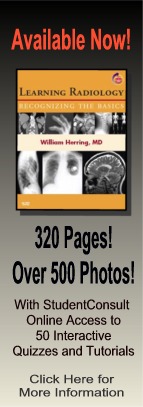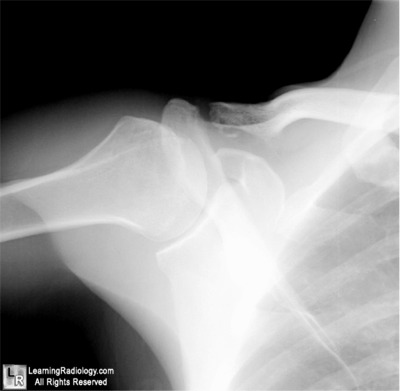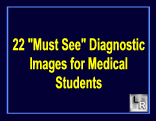| Cardiac | |
|---|---|
| GI | |
| Bone | |
| GU | |
| Neuro | |
| Peds | |
| Faculty | |
| Student | |
| Quizzes | |
| Image DDX | |
| Mobile | |
| |
Misc |
| Videocasts | |
What's the most likely diagnosis?
- 29 year-old male weight-lifter with shoulder pain
1. Posterior shoulder dislocation
2. Fractured 1st rib
3. Rheumatoid arthritis
4. Clavicular osteolysis
5. Hyperparathyroidism
Additional Image - Right Shoulder-Axillary View
![]()
Answer:
.
4. Clavicular osteolysis
.
.
More (Click Discussion Tab)
Distal Clavicular Osteolysis
General Considerations
- Sequela of trauma from contact sports, falls and motor vehicle accidents
- Incidence increased with weight lifting/training
- Other sports include football, swimming
- More often seen in males
- Unilateral
- Atraumatic causes are more common than traumatic
- Continued stress on the joint may play a role in its development
.
This Week
Test your skills in differentiating between accurate and inaccurate conclusions based on your observations ("good calls" versus "pitfalls".) Learn how to avoid the pitfalls. There is a mini-quiz at the end. |
Review descriptions of key imaging signs in the shorthand of Tweets by subscribing to this new LearningRadiology Twitter feed for your computer or cell phone
|
Key points on recognizing the most common fractures and dislocations |
Basic CT imaging of the brain focusing on the findings of cerebrovascular accidents |
The top diagnostic imaging diagnoses that all medical students should recognize according to the Alliance of Medical Student Educators in Radiology |
Recognizing normal and key abnormal intestinal gas patterns, free air and abdominal calcifications |
Some of the fundamentals of interpreting chest images |
| LearningRadiology.com |
is an award-winning educational website aimed primarily at medical students and radiology residents-in-training, containing lectures, handouts, images, Cases of the Week, archives of cases, quizzes, flashcards of differential diagnoses and “most commons” lists, primarily in the areas of chest, GI, GU cardiac, bone and neuroradiology. |




